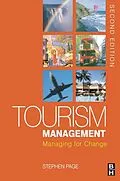Tourism Management: managing for change is a complete synthesis of tourism, from its beginnings through to the major impacts it has on today's global community, the environment and economy. Provocative and stimulating, it challenges the conventional thinking and generates reflection, thought and debate. This bestselling book is now in its second edition and has been fully revised with updated statistics and a complete set of brand new case studies.
Tourism Management covers the fundamentals of tourism, introducing the following key concepts:
* The development of tourism
* Tourism supply and demand
* Sectors involved: transport, accommodation, government
* The future of tourism: including forecasting and future issues affecting the global nature of tourism
In a user-friendly, handbook style, each chapter covers the material required for at least one lecture within a degree level course. Written in a jargon-free and engaging style, this is the ultimate student-friendly text, and a vital introduction to this exciting, ever-changing area of study.
The text is also accompanied by a companion website packed with extra resources for both students and lecturers. Accredited lecturers can request access to download additional material by going to http://textbooks.elsevier.com to request access.
Inhalt
Chapter 1: Introduction - Tourism Today - why is it a global phenomenon embracing all our lives?
Learning Outcomes
Introduction
Why study tourism? Is it just about enjoyment and holidays?
The leisure society
Concepts - tourism, the tourist and travel
An organising framework for the analysis of tourism
The tour, holidays and leisure trips
Measuring tourism
New forces affecting tourism - globalisation, inequality and the developed and developing world
A framework for the book
Tourism Management as the focus for the book
References
Further Reading
Questions
Chapter 2: Tourism - Its origins, growth and future
Learning Outcomes
Introduction
Tourism in classical times
The Middle Ages
The Renaissance and the Reformation
The European Grand Tour
Case study: Changing patterns of spa development in England 1558-1815
Tourism and the coast: The seaside resort
Tourism in the Edwardian and inter-war years
Post-war tourism: Towards international mass tourism
Case study: Forecasting international tourism growth in New Zealand
Space tourism
Conclusion
References
Further Reading
Questions
Chapter 3: Demand for tourism - Why do people engage in tourism?
Learning Outcomes
Introduction
What is tourism demand?
The motivation dichotomy: Why do people go on holiday?
Intrinsic and extrinsic motivation
Maslow's hierarchy model and tourist motivation
The tourism tradition of motivation studies: Classifying and understanding tourist motives
Consumer behaviour and tourism
Gender and ethnicity
Purchasing a holiday
The tourist image of products and places
Case study: The Chinese outbound tourism market
Conclusion
References
Further Reading
Questions
Chapter 4: The Supply of Tourism
Learning Outcomes
Introduction
Influences on Tourism Supply Issues: The Business Environment
Managing Tourism Supply Issues
Case Study: Corporate strategy and change in the hotel sector: The evolution of the Intercontinental Hotel Group
The tourism supply chain
Accommodation
Visitor attractions and activities
Case study: The impacts of sporting events - Hosting the 2012 London Olympic Games
Activities as a focus of tourism: Adventure tourism
Transport
Tourism organisations and agencies and the supply of tourism
Tourist Services and Facilities
Managing the supply of tourism in the new millennium
Conclusion
References
Further Reading
Questions
Chapter 5: Transporting the tourist I: Surface transport
Learning Outcomes
Introduction
Transport, tourism and the tour
Policy issues in tourist transport
The role of the EU in tourism and transport policy
Land-based transport
The car and tourist travel
Cycling
The UK's national cycle network
The coach and bus travel
Case study: Innovation in coach travel - Stagecoach's Megabus.com
Rail travel
Water-based transport
Ferries
Inland waterways
Boating on the Norfolk Broads: A tourist transport resource
Managing land and surface-based tourist transport
References
Further Reading
Questions
Chapter 6: Transporting the tourist II: The aviation sector
Learning Outcomes
Introduction
The role of the airport as a tourist terminal facility
What is an airport and how is it operated?
Future airport management issues: Safety, security and environmental concerns
The international airline industry
Trends in the industry in the new millennium
Managing the airline industry
Regulating international air transport
Airline marketing: Its role and recent innovations
How airlines use marketing functions
The low cost carriers: Aligning service provision to demand
The low cost carrier: The SouthWest phenomenon
Low cost carriers in Europe
Airline marketing and developing client relationships: Frequent flyer programmes and
alliances
In-flight catering: A marketing opportunity
Future trends
References
Further Reading
Questions
Chapter 7: Accommodation and Hospitality Services
Learning Outcomes
Introduction
The hospitality sector
The accommodation sector
The accommodation sector as a global phenomenon and operational issues
Case study: The German hotel industry
Types of tourist accommodation
The serviced accommodation sector: Hotels
The boutique hotel
Case study: Luxury travel and the accommodation sector
Budget accommodation and hotels
The non-serviced accommodation sector
Case study: The caravan industry in Europe
Current issues for the accommodation and hospitality sector
Conclusion
References
Further Reading
Questions
Chapter 8: Tour operating and travel retailing
Learning Outcomes
Introduction
The tour operator<…
